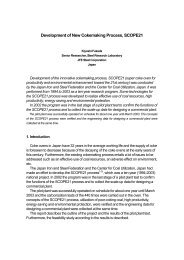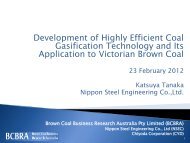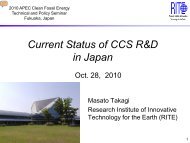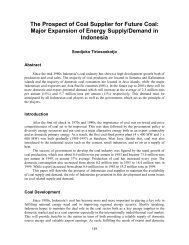Defining CCS Ready: An Approach to An International Definition
Defining CCS Ready: An Approach to An International Definition
Defining CCS Ready: An Approach to An International Definition
- No tags were found...
Create successful ePaper yourself
Turn your PDF publications into a flip-book with our unique Google optimized e-Paper software.
Appendix B: Technology Design Options for a Capture <strong>Ready</strong> PlantB.3 Pre-combustion CaptureFor flue gases with low CO 2 concentration, it would be useful <strong>to</strong> capture CO 2 prior <strong>to</strong>combustion. Such “pre-combustion” strives <strong>to</strong> separate the CO 2 from a process stream richin CO 2 prior <strong>to</strong> combustion of the remaining hydrogen-rich fuel.Prime candidates for pre-combustion CO 2 capture are Integrated Gasification CombinedCycle (IGCC) power plants. IGCCs generally use high-temperature oxygen-blown entrainedflow gasifiers. Syngas cooling can take place against boiler feedwater and steam in a syngascooler, or by means of a wet quench. Following this, a number of cleanup steps are used <strong>to</strong>clean the syngas of contaminants.Natural-gas-fired combined cycle power plants can also be equipped with pre-combustioncapture. For these gaseous fuels, the fuel conversion in<strong>to</strong> syngas is achieved through partialoxidation and/or steam reforming. If a combination of both is used, it is generally termedau<strong>to</strong> thermal reforming. As natural gas is a clean fuel, no elaborate cleaning is required, buthumidifying and possibly steam or water injection in the combustion chamber may still berequired <strong>to</strong> reduce NO x formation.<strong>An</strong> important consideration in IGCCs with pre-combustion CO 2 capture is whether <strong>to</strong>remove sulphur compounds before or after shifting. If removed before, it is called “sweetshift” (or clean shift). <strong>An</strong> advantage of this setup is that it is easier <strong>to</strong> remove a relativelypure sulphur (H 2 S) flow without dilution by CO 2 , as the latter is only present in smallquantities. If sulphur compounds are removed after shift, the setup is called “sour shift.”Advantages of this arrangement are a more level temperature profile, and thus higherefficiency, and no need for a separate COS hydrolysis reac<strong>to</strong>r as this reaction already takesplace in the shift reac<strong>to</strong>rs. Moreover, sour shift catalysts have a wider temperature window<strong>to</strong> operate in than sweet shift catalysts. Avoiding sulphur removal before shifting leavesmore steam in the syngas flow, requiring less additional steam for shifting.After water gas shift, the CO 2 is removed from the syngas. Technologies used includesolvents also used for desulphurization, such as Selexol or Rectisol. For IGCCs for bothsolvents, schemes have been proposed combining sulphur and CO 2 removal (in case a sourshift arrangement would be used). The resulting hydrogen-rich fuel stream cannot be fired ina gas turbine equipped with dry low-NO x combustion chambers, due <strong>to</strong> the wideflammability limits and high flame speed of hydrogen. Therefore, diffusion flame combustionchambers are needed, the hydrogen-rich fuel stream needs <strong>to</strong> be humidified, and nitrogenneeds <strong>to</strong> be added (as is also done in IGCCs without CO 2 capture) <strong>to</strong> reduce NO xformation. Exhibit B-8 shows an IGCC equipped with pre-combustion CO 2 capture using asour shift.One drawback of pre-combustion method is that there are only a small number of IGCCplants, while the industry has much more experience in PC plants. In recent years, however,many coal gasifiers have been built for chemicals production, and the reliability of IGCCplants currently running (such as Nuon’s Willem Alexander Centrale in Buggenum, TheNetherlands) matches that of PC plants.23 February 2010 88
















